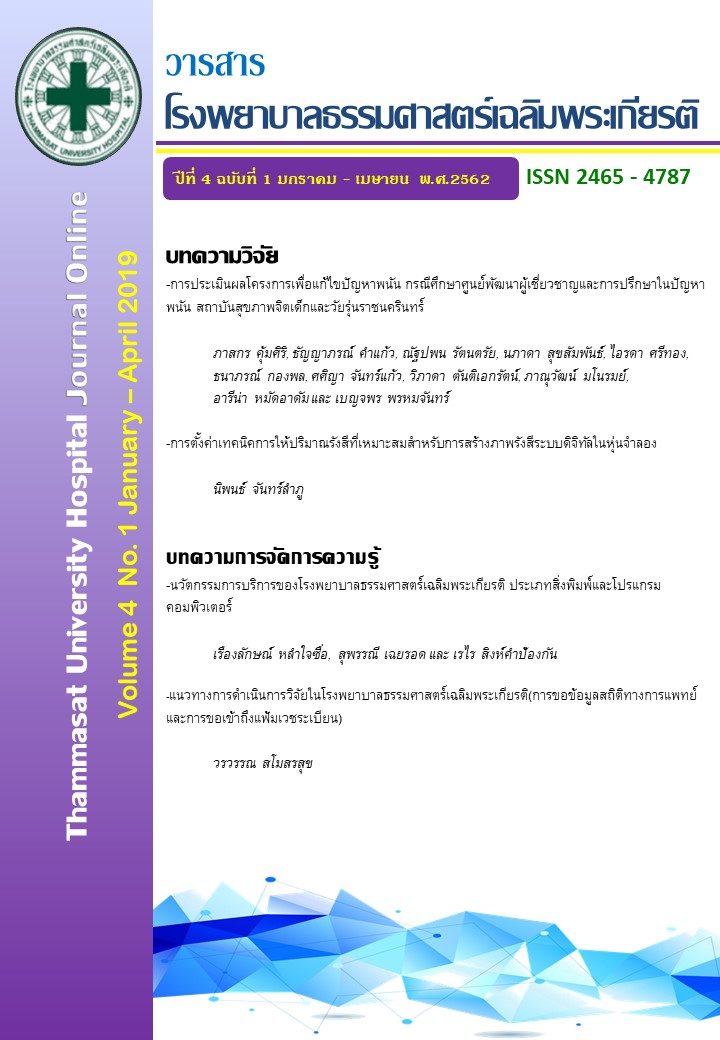Optimization of the Exposure Techniques for Digital Radiography in Phantom
Keywords:
Exposure Technique, Exposure Index:, Deviation Index:DI, Target Exposure Index:EIT, Entrance Surface Air Kerma:ESAKAbstract
Background: The factor of radiography is an exposure technique that relates to the kilovoltage peak (kVp) and milliampere seconds (mAs). In digital radiography, it is difficult to evaluate if the exposure technique is appropriate. In addition to considering the exposure index (EI) and deviation index(DI), which is an indication of the quality of digital radiography.
Objective: To set the exposure technique for appropriate digital radiography.
Method: This was the experimental study, by taking a radiography in Helios QA phantom. Analysis the relationship of exposure techniques with the exposure index and deviation index were performed. The study used exposure technique associated at 80 kVp and target exposure index (EIT) 400 with adjusted mAs at 4-16 mAs, the amount of entrance surface air kerma was calculated from the setting of exposure techniques.
Results: The appropriated exposure technique is the 300–600 of exposure index and the deviation index of ± 2 is 80 kVp 6.3-10 mAs.The amount of entrance surface air kerma receive is 0.44-0.70 mGy, and the optimized exposure technique for digital radiography was at 80 kVp 7.1 mAs, when set EIT400.
Conclusion: Optimization of the exposure techniques for digital radiography can be analyzed from the exposure index that is equal to or close to the specified target exposure index (EIT) and the deviation index(DI), that is equal to 0 or the closest. Knowing the entrance surface air kerma will help to adjust the exposure technique an reduce the radiation dose to the patient.
References
เอกสารอ้างอิง
เพชรากร หาญพานิชย์ และ วัลลภ เหล่าไพบูลย์. ระบบสื่อสารและการเก็บข้อมูลภาพทางการแพทย์ [อินเตอร์เน็ต]. 2550[เข้าถึงเมื่อ10สิงหาคม 2561]; 22:115-123. เข้าถึงได้จาก: https://www. smj.ejnal.com/e-journal/showdetail /?show_detail-T&art_id-1339
ชวลิต วงษ์เอก. เทคนิคการให้ปริมาณรังสีเพื่อถ่ายภาพเอกซเรย์. [อินเตอร์เน็ต].[เข้าถึงเมื่อ10 สิงหาคม 2561]; เข้าถึงได้จาก: https:// www. mt.mahidol.ac.th/ e-learning/MTRD310/w%20second /s1.htm
Seeram E, Davidson R, Bushong S, Swan H. Optimizing the exposure indicator as a dose management strategy in computed radiography. Radiol Technol 2016; 87(4):381-91.
Seeram E, Davidson R, Bushong S, Swan H. Radiation dose optimization research: exposure technique approaches in CR imaging: A literature review Radiography 2013; 19(4):331-8.
Brindhaban A, Al Khalifah K. Radiation dose in pelvic imaging. Radiol technol. 2005; 77(1):32-40.
Geijer H, Norrman E, Persliden J. Optimizing the tube potential for lumbar spine radiography with a flat-panel digital detector. Br J Radiol 2009; 82(973):62-8.
Fauber TL, Cohen TF, Dempsey MC. High kilovoltage digital exposure techniques and patient dosimetry. Radiol Technol 2011; 82(6):501-10.
Tilak RD, Shanthi K. Analysis on x-ray parameters of exposure by measuring x-ray tube voltage and time of exposure. The IJES 2014; 3(6):69-73.
Uffmann M, Neitzel U, Prokop M, et al. Flat-panel-detector chest radiography:effect of tube voltage on image quality. Radiology 2005; 235:642–50.
Uffmann M, Schaefer-Prokop C. Digital radiography: the balance between image quality and required radiation dose. Eur J Radiol 2009; 72(2):202-8.
Don S, Whiting BR, Rutz LJ, Apgar BK. New exposure indicators for digital radiography simplified for radiologists and technologists. AJR 2012; 199(6):1337-41.
บรรจง เขื่อนแก้ว. คุณภาพของภาพรังสี. พิมพ์ครั้งที่ 1. ขอนแก่น: หจก.โรงพิมพ์คลังนานาวิทยา, 2551.
American Association of Physicists in Medicine. AAPM report No.116: An exposure indicator for digital radiography.[internet]. 2009[cited 2018 August 10]. Available from: https://www.aapm.org/pubs/reports /RPT_116.pdf



